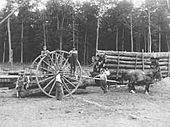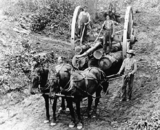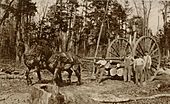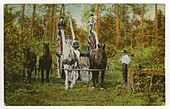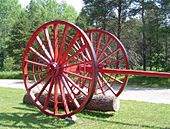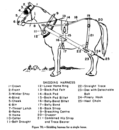Michigan logging wheels facts for kids
Quick facts for kids Michigan logging wheels |
|
|---|---|
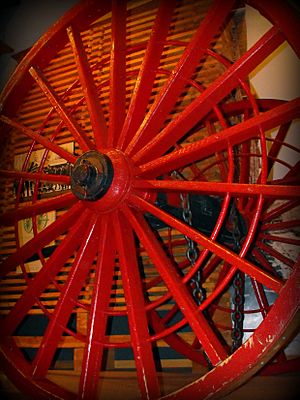
Single logging wheel
|
|
| Classification | Vehicle |
| Industry | Logging |
| Application | hauling |
| Fuel source | Hay or fodder |
| Powered | Labor animals (draft horses) |
| Self-propelled | no |
| Wheels | 2 |
| Axles | 1 |
| Inventor | Silas C. Overpack |
| Invented | 1875 |
| Examples | Gallery |
Michigan logging wheels were huge, special wagons used in the 1800s to move big logs. They were like super-strong carts that helped loggers transport heavy trees through tough, muddy forests. These wheels were a big deal because they let people cut and move timber even in winter, when the ground wasn't frozen. This meant the logging season could last longer.
These amazing wheels allowed strong labor animals, like horses, mules, or oxen, to pull many heavy logs at once. They could travel long distances over bumpy, wet ground.
A clever inventor named Silas C. Overpack created these wheels in 1875. At first, he made them one by one. But soon, everyone wanted them, so he started making lots of them! These giant wheels were always painted red. They came in different sizes, usually about 10 feet (3 meters) tall. Sometimes they were a bit smaller or larger, from 9 to 11 feet (2.7 to 3.3 meters) tall. They were quite expensive, but logging companies bought many of them. This helped them save money on labor.
Contents
How Michigan Logging Wheels Changed Logging
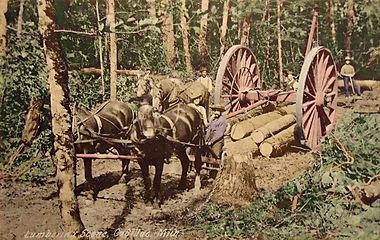
People often called Michigan logging wheels "high wheels." They also had other names like big wheels, logging wheels, or log bummer carts. These were special horse-drawn vehicles used to drag or skid logs. They made a huge difference for the logging industry in the North Woods of Michigan.
Before these wheels, loggers needed frozen, icy ground to move timber. The high wheels changed everything! They allowed loggers to work even when the ground was soft or muddy. These giant wooden wheels were designed to carry several felled trees at once. Some logs could be up to 100 feet (30 meters) long. Before, loggers could only pull one log at a time.
The Inventor: Silas C. Overpack
Silas C. Overpack first built his Michigan logging wheels in 1875. A farmer asked him to make them because he needed a better way to move logs over soft ground. At that time, Michigan was a top producer of cut trees for lumber. Overpack always painted his high wheels red.
Overpack's logging wheels could haul logs without needing icy ground. They did not get stuck in the mud during the spring thaw, unlike regular wagon wheels. This meant logging could happen year-round. These wheels allowed a team of horses or other animals to pull many logs at once.
Overpack owned a wagon factory in Manistee, Michigan. He was good at making wooden wheels. A farmer asked him to build a pair of very large 8-foot (2.4-meter) wagon wheels. Later, the same farmer returned, asking for an even bigger pair! When Overpack asked why, the farmer explained he was using them with horses to drag logs out of his muddy woods.
From then on, Overpack's big wheels became a key part of Michigan's logging history. Many northern states used them. In Michigan alone, at least 65 different lumber companies bought dozens of these wheels. This helped them save on labor costs.
In the 1800s, Michigan's rough and wet forests meant logging was mostly done in winter. Loggers used the frozen ground to slide logs from the woods to railheads or river banks. In spring, they would float the logs down rivers to sawmills. Overpack's wheels made it possible to log all year long.
Spreading the Word About Big Wheels
Overpack showed his Michigan logging wheels at the 1893 World's Columbian Exposition in Chicago. People were very interested! The wheels quickly became popular in the timber industry across the country. They even won a medal and a top award at this World's Fair.
To help get his wheels to the western United States, Overpack worked with the Redding Iron Works Company. This company was on the West Coast, which was perfect for the western timber industry. They later started building Overpack's logging wheels too.
Overpack began making thousands of logging wheels. He sold them all over the world, shipping them by train to other states and Canada. The U.S. Army Forestry Department even took some to France during World War I. The use of logging wheels ended around 1937.
Different Sizes and How They Worked
Overpack sold three main sizes of big wheels: 9 feet (2.7 meters), 9 feet 6 inches (2.9 meters), and 10 feet (3 meters) in diameter. They cost $100 per foot of diameter, which was a lot of money back then.
Unlike a regular wagon that carries its load on top of the axle, these huge wheels carried logs suspended by chains beneath the axle. These wheels could carry logs from 12 to 100 feet (3.6 to 30 meters) long. They could move enough logs to make 1,000 to 2,000 board feet (2.3 to 4.7 cubic meters) of lumber in one trip.
The axles were made of strong maple wood. The 16-foot (4.8-meter) long tongues were made of ironwood. The wheels had outer iron rims to protect them from stumps, fallen trees, and rocks. Inside, iron rings made the wooden spokes even stronger. In the 1800s, Horses, oxen, or mules pulled them. In the early 1900s, tractors started to be used as the power source.
Where to See Logging Wheels Today
When most of the trees in New England were cut down, loggers moved west. They went to states like Michigan, Wisconsin, and Minnesota. In the early 1900s, Michigan decided to protect its natural resources, including forests. This caused logging to move even further west.
Today, you can find these logging wheels as museum pieces in different places across the United States.
- Redding, California
- Grayling, Michigan
- Manistee, Michigan
- Northern Arizona University
- Hartwick Pines Logging Museum
- Red Rock State Park, Sedona, Arizona
- White Pine Village at Ludington, Michigan
- Riordan Mansion State Historic Park, Flagstaff, AZ
- University of Montana College of Forestry and Conservation
Images for kids
- Michigan logging wheels examples
-
Skidding horse with harness


